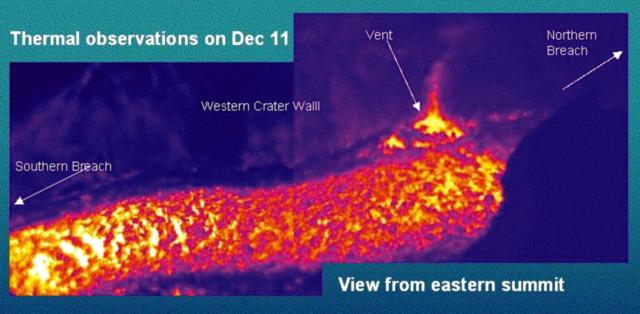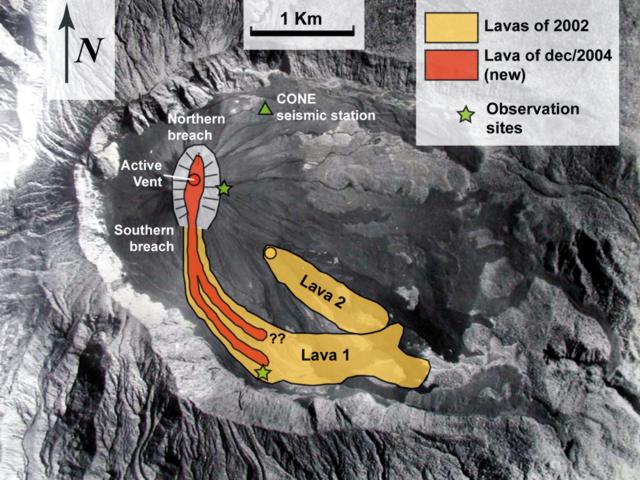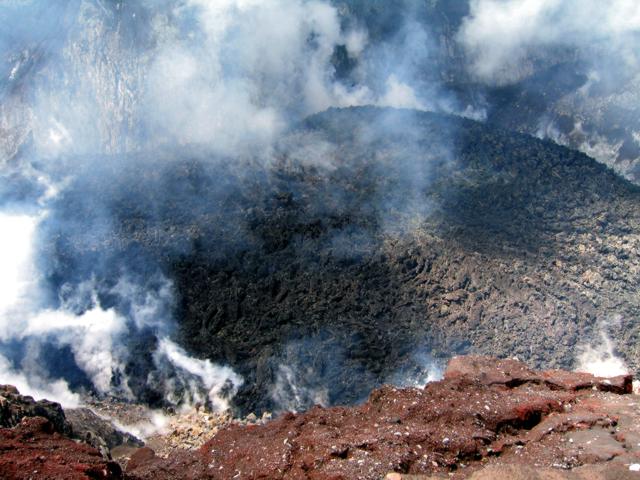Report on Reventador (Ecuador) — November 2004
Bulletin of the Global Volcanism Network, vol. 29, no. 11 (November 2004)
Managing Editor: Richard Wunderman.
Reventador (Ecuador) Late 2004 visits find renewed venting and thick intracaldera lava flows 2 km long
Please cite this report as:
Global Volcanism Program, 2004. Report on Reventador (Ecuador) (Wunderman, R., ed.). Bulletin of the Global Volcanism Network, 29:11. Smithsonian Institution. https://doi.org/10.5479/si.GVP.BGVN200411-352010
Reventador
Ecuador
0.077°S, 77.656°W; summit elev. 3562 m
All times are local (unless otherwise noted)
A 16 December 2004 report from the Instituto Geofísico (IG) of the Escuela Politécnica Nacional calls attention to renewed lava effusion from the crater that lies within Reventador's large summit cone (figure 13). A block-lava flow escaped the cone's crater. It ran out at a breach in the S wall, and by 16 December it had advanced ~ 2 km farther. The flow advanced SE along a narrow, E-curving path, remaining atop lavas from 2002. Thus far in 2004, lava flows remained well within the larger caldera.
Reports in 2003 chiefly discussed events outside the caldera. A road, one gas pipeline, and two oil pipelines traverse Reventador's flanks 7 km ESE of the active vent. All of these installations were affected in 2003 (but not appreciably since then). The pipelines were destroyed due to heavy lahars coming down the Reventador river on 6 May 2003 (BGVN 28:06). Our last report (BGVN 28:11) discussed events during July through most of November 2003.
Lava venting in the crater likely began in early November 2004, a time when seismic station CONE registered dramatic increases in volcano-tectonic events (figure 14). In response to the elevated seismicity, the IG-EPN began more intensive monitoring, including overflights with thermal imaging, repeat visits to the remote volcano, and on 9 November 2004, installation of the additional short-period seismic station LAV3, ~ 2 km from the crater's vent.
A helicopter overflight by IG-EPN staff on 10 November 2004 confirmed the presence of a small lava dome, which appeared then to be confined to the crater floor. This feature was not present on photos taken during an IG overflight on 19 October 2004. During the 10 November overflight, a continuous 2.5 km-high gas column escaped from the crater, accompanied by sulfurous odors detected by personnel in the helicopter.
The date when lava began escaping the crater was not precisely known, but it was thought to have been around 22 November, coincident with the emergence of distinct seismic signals not previously observed at Reventador (figure 11). The signals occurred in swarms and consisted of low-frequency (1-10 Hz) waves of relatively low-amplitude. Their seismic records were emergent (i.e. growing in amplitude with time) and of long duration (up to 60 seconds). They are thought to have been possibly associated with rock falls from lava flowing down the cone's southern flank. As many as 200 of these events were recorded each day at station CONE.
A return visit to the crater rim on 28 November (this time on foot) documented abundant fresh lava in the crater (figure 15), a dramatic increase in the volume of lava there. At least 0.5 x 106 m3 of new lava then covered the entire crater floor and appeared to be already flowing out of the southern breach and into the surrounding caldera. Because of cloudy weather, the exact extent of the flow remained indeterminate. The surface of this lava flow also extended to the N and reached a level ~ 20 m below the northern breach. Continuous lava extrusion or flowing or both were heard within the crater, making sounds akin to glass breaking, and vigorous roaring gas emissions originated from the crater's western margin. These gas emissions and other smaller fumaroles contributed to a plume that was continuously present, extending at least 1 km above the vent.
IG observers estimated that the total mid-December lava flow volume was ~ 3 x 106 m3. The inferred 22 November date of flow onset would imply a steady-state extrusion rate of ~ 0.1 x 106 m3 per day and a flow front advancing at ~ 80 m per day. These observations appear to conform with satellite thermal infrared observations, which noted no significant anomalies until the end of November, due presumably in large part to the lava being confined within the steep-walled crater. Inclement weather occurred and also may have impeded some of the satellite thermal observations.
The most recent visit to the crater rim, on 11 December 2004, traced the source of degassing and lava outflow to the most elevated portion of a small dome-like feature at the central western margin of the crater. Figure 16 shows how instrumentally aided nighttime incandescence observations disclosed both the vent area and surficial flow-textures extending S towards the southern breach of the cone. Figure 14 also documents a comparatively narrow arm of lava trending towards the cone's northern breach. Nighttime incandescence from the lava flow was also visible from local communities such as El Chaco, ~ 20 km distant.
 |
Figure 16. Thermal image of the lava flow in the interior of Reventador crater taken with a Forward Looking Infrared (FLIR) imager at 2000 on 11 December 2004. Courtesy of IG. |
Figure 17 illustrates the scene on 12 December 2004 during a visit to the front of the most advanced lobe of lava (for location, see star at end of flow lobe, figure 9). IG-EPN staff estimated the flow front at ~ 20 m high and saw incandescent blocks falling off of it.
Geological Summary. Volcán El Reventador is the most frequently active of a chain of Ecuadorian volcanoes in the Cordillera Real, well east of the principal volcanic axis. The forested, dominantly andesitic stratovolcano has 4-km-wide avalanche scarp open to the E formed by edifice collapse. A young, unvegetated, cone rises from the amphitheater floor to a height comparable to the rim. It has been the source of numerous lava flows as well as explosive eruptions visible from Quito, about 90 km ESE. Frequent lahars in this region of heavy rainfall have left extensive deposits on the scarp slope. The largest recorded eruption took place in 2002, producing a 17-km-high eruption column, pyroclastic flows that traveled up to 8 km, and lava flows from summit and flank vents.
Information Contacts: Patricio Ramón, Daniel Andrade, David Rivero, Alexandra Alvarado, Sandro Vaca, and Pete Hall, Geophysical Institute (IG), Escuela Politécnica Nacional, Apartado 17-01-2759, Quito, Ecuador (URL: http://www.igepn.edu.ec/); Jeffrey B. Johnson, Dept. of Earth Sciences, James Hall University of New Hampshire, Durham, NH 03824; MODIS Thermal Alert System, Hawaii Institute of Geophysics and Planetology (HIGP), School of Ocean and Earth Science and Technology, University of Hawaii at Manoa (URL: http://modis.higp.hawaii.edu/).




